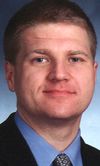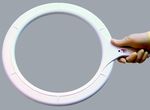Medline Industries, a U.S. distributor of medical supplies, has begun marketing a medical system that uses radio frequency (RF) to detect any surgical gauze, towels and sponges left behind in human bodies after an operation. The Mundelein, Ill., distributor says the first orders will begin shipping the system, called RF-Detect, to hospitals in December. Two hospitals should have the system running by early January, with 10 centers adopting it during the first quarter of 2007.
RF Surgical Systems, medical device company based in Bellevue, Wash., developed RF-Detect, which received U.S. Food and Drug Administration regulatory approval on Nov. 3. The platform aims to augment manual procedures in place that require surgical teams to count equipment before performing operations and then recount just prior to sewing up the body.
The sponges do not contain passive RFID tags, however, but rather much simpler RF tags that work akin to electronic article surveillance (EAS) tags used by some retailers. An RF tag emits a signal when within range of reader, but that signal is not encoded with a unique identification number, as would be the case with an RFID tag.
“Although nurses do a good job keeping track of sponges, gauze and instruments in the operating room, there are several patients who retain objects in their body,” says Jeffery Port, chairman of RF Surgical and thoracic surgeon at Weill-Cornell Medical Center in Manhattan. “The fear that we’re going to leave something behind also creates chaos when manually counting equipment after the operation.”
RF-Detect is the brainchild of Port, who dreamed up the concept 10 years ago and presented it to electrical engineer William Blair, now RF Surgical’s chief technology officer, after becoming concerned about incorrect equipment counts following surgical procedures. The two men jointly designed the system and founded the company.In 2004, as the technology matured, they built a prototype system.
The platform now consists of passive RF 145 kHz tags, about the size of a rice kernel, embedded in surgical gauze, sponges and instruments; areader; and a handheld wand containing an antenna connected to the interrogator. To detect any tagged items left a patient’s body, hospital personnel pass a handheld wand over the patient. The reader would then pick up the RF signals of any tag items left in the patient’s body.
The system is not able to count the tags and therefore isn’t meant to replace the process of manually recounting sponges and equipment following an operation, but rather provide a safeguard, says Port, who notes a study released by the New England Journal of Medicine in 2003 exemplifies his concerns. The study found 61 foreign objects in 54 out of 235 patients, of which 69 percent were sponges and 31 percent instruments.
The problem: Sponges are porous, which means that if they are left in a body, they can calcify over time, leading doctors to mistake them for tumors years after an operation. Port says patients go to doctors as adults with an infection only to discover they retained gauze inside their body from a childhood operation.
Although surgical equipment is counted before and after each operating procedure, RF Surgical’s Port estimates that “10 percent of counts after a complex operation are incorrect,” and often solved by rummaging through mounds of blood-soaked sponges and gauze. “About 1 percent of all cases require an X-ray, which means waiting between 30 and 40 minutes for a technician to put on the correct attire and bring in a portable machine into the operating room to look for lost items,” he says.
With approximately 20 million operations done in the United States annually, Port estimates RF Surgical could require its unnamed contract manufacturing facilities in China to produce about a billion tags each year to meet demand. And at a cost of about $50 for the tagged surgical sponges and gauze per operating procedure that could protect patients, the technology could catch on quick.
RF Surgical isn’t the only company to develop an RF-based system for surgical sponges. Pittsburgh-based ClearCount Medical Solutions has developed a system that uses passive RFID tags and readers to identify and count sponges. ClearCount expects its SmartSponge System (see Surgical Sponges Get Smart) will gain FDA approval early in 2007, according to Gautam Gandhi, the company’s cofounder and chief marketing officer.



